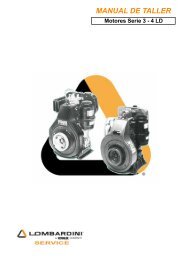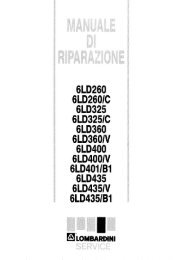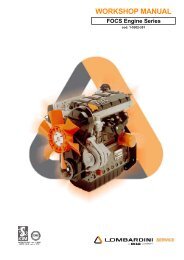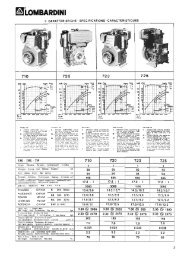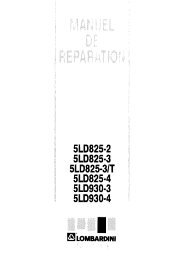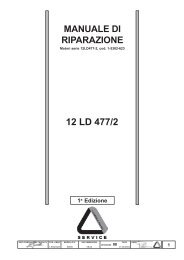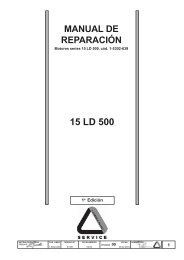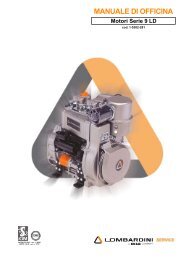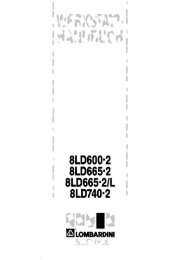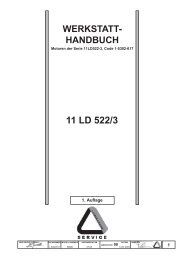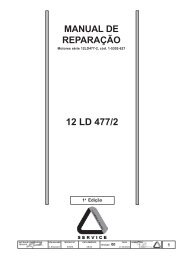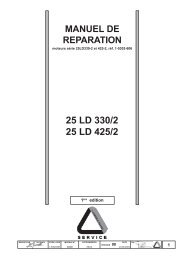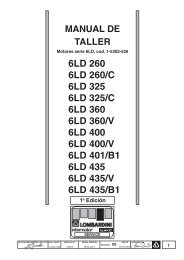WORKSHOP MANUAL - lombardini service
WORKSHOP MANUAL - lombardini service
WORKSHOP MANUAL - lombardini service
Create successful ePaper yourself
Turn your PDF publications into a flip-book with our unique Google optimized e-Paper software.
General remarks and safety information<br />
1<br />
− During operation, the surface of the engine can become dangerously hot.<br />
Avoid touching the exhaust system in particular.<br />
− Before proceeding with any operation on the engine, stop it and allow it to cool.<br />
Never carry out any operation whilst the engine is running.<br />
− The coolant fluid circuit is under pressure.<br />
Never carry out any inspections until the engine has cooled and even in this case, only open the radiator plug or<br />
expansion chamber with the utmost caution, wearing protective garments and goggles. If there is an electric fan, do not<br />
approach the engine whilst it is still hot as the fan could also start operating when the engine is at a standstill.<br />
Only clean the coolant system when the engine is at a standstill.<br />
− When cleaning the oil-cooled air filter, make sure that the old oil is disposed of in the correct way in order to safeguard<br />
the environment.<br />
The spongy filtering material in oil-cooled air filters must not be soaked in oil.<br />
The reservoir of the separator pre-filter must not be filled with oil.<br />
− The oil must be drained whilst the engine is hot (oil T ~ 80°C).<br />
Particular care is required to prevent burns.<br />
Do not allow the oil to come into contact with the skin.<br />
− Pay attention to the temperature of the oil filter when the filter itself is replaced.<br />
− Only check, top up and change the coolant fluid when the engine is off and cold.<br />
Take care to prevent fluids containing nitrites from being mixed with others that do not contain these substances since<br />
"Nitrosamine", dangerous for the health, can form.<br />
The coolant fluid is polluting and must therefore be disposed of in the correct way to safeguard the environment.<br />
− During operations that involve access to moving parts of the engine and/or removal of rotating guards, disconnect and<br />
insulate the positive wire of the battery to prevent accidental short-circuits and to stop the starter motor from being<br />
energized.<br />
− Only check belt tension when the engine is off.<br />
− Only use the eyebolts installed by LOMBARDINI to move the engine.<br />
These lifting points are not suitable for the entire machine; in this case, the eyebolts installed by the manufacturer should<br />
be used.<br />
GENERAL SAFETY DURING OPERATING PHASES<br />
– The procedures contained in this manual have been tested and selected by the manufacturer’s technical experts, and hence<br />
are to be recognised as authorised operating methods.<br />
– A number of procedures must be carried out with the aid of equipment and tools that simplify and improve the timing of<br />
operations.<br />
– All tools must be in good working condition so that engine components are not damaged and that operations are carried out<br />
properly and safely.<br />
It is important to wear the personal safety devices prescribed by work safety laws and also by the standards of this manual.<br />
– Holes must be lined up methodically and with the aid of suitable equipment. Do not use your fingers to carry out this operation<br />
to avoid the risk of amputation.<br />
– Some phases may require the assistance of more than one operator. If so, it is important to inform and train them regarding<br />
the type of activity they will be performing in order to prevent risks to the health and safety of all persons involved.<br />
– Do not use flammable liquids (petrol, diesel, etc.) to degrease or wash components. Use special products.<br />
– Use the oils and greases recommended by the manufacturer.<br />
Do not mix different brands or combine oils with different characteristics.<br />
– Discontinue use of the engine if any irregularities arise, particularly in the case of unusual vibrations.<br />
– Do not tamper with any devices to alter the level of performance guaranteed by the manufacturer.<br />
SAFETY AND ENVIRONMENTAL IMPACT<br />
Every organisation has a duty to implement procedures to<br />
identify, assess and monitor the influence of its own activities<br />
(products, <strong>service</strong>s, etc.) on the environment.<br />
Procedures for identifying the extent of the impact on the<br />
environment must consider the following factors:<br />
- Liquid waste<br />
- Waste management<br />
- Soil contamination<br />
- Atmospheric emissions<br />
- Use of raw materials and natural resources<br />
- Regulations and directives regarding environmental impact<br />
In order to minimise the impact on the environment, the<br />
manufacturer now provides a number of indications to be<br />
followed by all persons handling the engine, for any reason,<br />
during its expected lifetime.<br />
- All packaging components must be disposed of in accordance<br />
with the laws of the country in which disposal is taking place.<br />
- Keep the fuel and engine control systems and the exhaust<br />
pipes in efficient working order to limit environmental and<br />
noise pollution.<br />
- When discontinuing use of the engine, select all components<br />
according to their chemical characteristics and dispose of<br />
them separately.<br />
FOCS Workshop Manual_cod. 1.5302.858_1° ed_ rev. 00<br />
- 11 -



